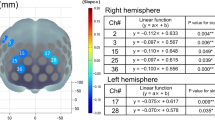Abstract
We have compared functional MRI signals in primary sensorimotor cortex (SM1) during a paced motor task of each hand before and after unimanual (right hand) fatiguing exercise. Our aims were to determine whether the degree of activation is different when a motor task is performed after a fatiguing exercise, and whether there are any differences in activation between movement of the fatigued and non-fatigued hands. There was a significant reduction in the number of voxels activated in SM1 in the hemisphere contralateral to movement of both the fatigued hand (38±5 pre-exercise versus 21±3 post-exercise; P<0.05) and the non-fatigued hand (32±4 pre-exercise vs 18±4 post-exercise; P<0.05). There was no significant difference in the magnitude of the functional magnetic resonance imaging signal before or after exercise, however, the variance increased significantly after exercise (6.0±0.5 pre-exercise vs 7.3±0.6 post-exercise; P<0.01). Reduced functional activation in SM1 may reflect increased variability in the activation rather than a reduction in activation of cortical motor networks after fatigue.



Similar content being viewed by others
References
Baker AJ, Kostov KG, Miller RG, Weiner MW (1993) Slow force recovery after long-duration exercise: metabolic and activation factors in muscle fatigue. J Appl Physiol 74:2294–2300
Benwell NM, Thickbroom GW, Sacco P, Hammond G, Byrnes ML, Mastaglia FL (2003) Changes in intracortical inhibition with fatigue of the hand. Proceedings of the Australian Neuroscience Society 14:O-06
Bonato C, Zanette G, Manganotti P, Tinazzi M, Bongiovanni G, Polo A, Fiaschi A (1996) ‘Direct’ and ‘crossed’ modulation of human motor cortex excitability following exercise. Neurosci Lett 216:97–100
Brasil-Neto JP, Pascual-Leone A, Valls-Sole J, Cammarota A, Cohen LG, Hallett M (1993) Post-exercise depression of motor evoked potentials: a measure of central nervous system fatigue. Exp Brain Res 93:181–184
Fitts RH (1994) Cellular mechanisms of muscle fatigue. Physiol Rev 74:49–94
Gandevia SC, Allen GM, Butler JE, Taylor JL (1996) Supraspinal factors in human muscle fatigue: evidence for suboptimal output from the motor cortex. J Physiol (Lond) 490:529–536
Gonzalez-Alonso J, Dalsgaard MK, Osada T, Volianitis S, Dawson EA, Yoshiga CC, Secher NH (2004) Brain and central haemodynamics and oxygenation during maximal exercise in humans. J Physiol 557:331–342
Lazarski JP, Ridding MC, Miles TS (2002) Dexterity is not affected by fatigue-induced depression of human motor cortex excitability. Neurosci Lett 321:69–72
Liu JZ, Dai TH, Sahgal V, Brown RW, Yue GH (2002) Nonlinear cortical modulation of muscle fatigue: a functional MRI study. Brain Res 957:320–329
Liu JZ, Shan ZY, Zhang LD, Sahgal V, Brown RW, Yue GH (2003) Human brain activation during sustained and intermittent submaximal fatigue muscle contractions: an FMRI study. J Neurophysiol 90:300–312
McLester JR Jr (1997) Muscle contraction and fatigue. The role of adenosine 5′-diphosphate and inorganic phosphate. Sports Med 23:287–305
Sacco P, Thickbroom GW, Thompson ML, Mastaglia FL (1997) Changes in corticomotor excitation and inhibition during prolonged sub-maximal muscle contractions. Muscle Nerve 20:1158–1166
Samii A, Wassermann EM, Ikoma K, Mercuri B, Hallett M (1996) Characterization of postexercise facilitation and depression of motor evoked potentials to transcranial magnetic stimulation. Neurology 46:1376–1382
Samii A, Canos M, Ikoma K, Wassermann EM, Hallett M (1997) Absence of facilitation or depression of motor evoked potentials after contralateral homologous muscle activation. Electroencephalogr Clin Neurophysiol 105:241–245
Taylor JL, Butler JE, Allen GM, Gandevia SC (1996) Changes in motor cortical excitability during human muscle fatigue. J Physiol (Lond) 490:519–528
Thickbroom GW, Phillips BA, Morris I, Byrnes ML, Sacco P, Mastaglia FL (1999) Differences in functional magnetic resonance imaging of sensorimotor cortex during static and dynamic finger flexion. Exp Brain Res 126:431–438
Waldvogel D, van Gelderen P, Muellbacher W, Ziemann U, Immisch I, Hallett M (2000) The relative metabolic demand of inhibition and excitation. Nature 406:995–998
Acknowledgements
We are grateful to Dr V Low (Head) and radiographers at the MRI Unit, Department of Radiology, Sir Charles Gairdner Hospital, for their support and assistance in carrying out these studies. Peter Clissa is thanked for technical advice. This study was supported by the Neuromuscular Foundation of Western Australia. NMB is a recipient of an Australian Postgraduate Award, Jean Rogerson Postgraduate Scholarship and 2004 Woodside Neurotrauma PhD Excellence Award.
Author information
Authors and Affiliations
Corresponding author
Rights and permissions
About this article
Cite this article
Benwell, N.M., Byrnes, M.L., Mastaglia, F.L. et al. Primary sensorimotor cortex activation with task-performance after fatiguing hand exercise. Exp Brain Res 167, 160–164 (2005). https://doi.org/10.1007/s00221-005-0013-2
Received:
Accepted:
Published:
Issue Date:
DOI: https://doi.org/10.1007/s00221-005-0013-2




